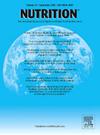Nutritional risk assessment using the Nutritional Prognostic Index predicts mortality in Advanced Chronic Liver Disease patients
IF 3.2
3区 医学
Q2 NUTRITION & DIETETICS
引用次数: 0
Abstract
Objectives
Early clinical prognosis and mortality reduction remains a challenge in chronic liver disease (CLD). The full potential of the Nutritional Prognostic Index (NPI) for nutritional assessment and management in CLD patients remains unexplored. The aim of this study was to establish an NPI cutoff point for the identification of nutritional risk in advanced CLD (ACLD) patients, as well as to assess the NPI's ability to predict ACLD-associated mortality.
Methods
This ethically approved prospective cohort study investigated malnutrition risk using both the NPI and the Royal Free Hospital-Nutritional Prioritizing Tool (RFH-NPT) in patients hospitalized for ACLD. NPI reference values were determined using a receiver operating characteristic curve. Associations between nutritional risk identified by the RFH-NPT and the NPI were assessed using Fisher's exact test, and agreement between tools was assessed using the Kappa index. The association between NPI-defined nutritional risk and 12-mo mortality was examined using Pearson Chi-square test.
Results
The sample population consisted of 120 adults, comprising 84 (70%) male and 57 (50.9%) of alcoholic etiology and presenting as Child-Pugh A, B, or C at admission. The identified cutoff point for NPI was <41, identifying nutritional risk in 82.5% of patients. The NPI presented a statistically significant association with the RFH-NPT, with a substantial agreement coefficient of 0.34. An association between NPI <41 cutoff and mortality were observed, with 82.1% of the sample below cutoff experiencing mortality within 12 mo.
Conclusions
The NPI is a valuable nutritional marker for the identification of nutritional risk in ACLD and is a simple and effective assessment tool that can aid in early CLD prognosis assessment. Validation, however, remains necessary in other CLD populations of different etiologies.
使用营养预后指数进行营养风险评估可预测晚期慢性肝病患者的死亡率。
目的:早期临床预后和降低死亡率仍是慢性肝病(CLD)的一项挑战。营养预后指数(NPI)在慢性肝病患者营养评估和管理方面的全部潜力仍有待开发。本研究的目的是为晚期慢性肝病(ACLD)患者的营养风险识别确定一个 NPI 临界点,并评估 NPI 预测 ACLD 相关死亡率的能力:这项获得伦理批准的前瞻性队列研究使用 NPI 和皇家自由医院营养优先工具 (RFH-NPT) 对 ACLD 住院患者的营养不良风险进行了调查。采用接收者操作特征曲线确定 NPI 参考值。RFH-NPT和NPI确定的营养风险之间的关联采用费舍尔精确检验进行评估,工具之间的一致性采用Kappa指数进行评估。NPI 定义的营养风险与 12 个月死亡率之间的关系采用皮尔逊卡方检验:样本人群包括 120 名成年人,其中 84 名(70%)男性,57 名(50.9%)酗酒者,入院时表现为 Child-Pugh A、B 或 C。确定的 NPI 临界点为结论:NPI 是识别 ACLD 营养风险的重要营养标志物,也是一种简单有效的评估工具,有助于早期 CLD 预后评估。但是,仍有必要在其他不同病因的慢性营养不良人群中进行验证。
本文章由计算机程序翻译,如有差异,请以英文原文为准。
求助全文
约1分钟内获得全文
求助全文
来源期刊

Nutrition
医学-营养学
CiteScore
7.80
自引率
2.30%
发文量
300
审稿时长
60 days
期刊介绍:
Nutrition has an open access mirror journal Nutrition: X, sharing the same aims and scope, editorial team, submission system and rigorous peer review.
Founded by Michael M. Meguid in the early 1980''s, Nutrition presents advances in nutrition research and science, informs its readers on new and advancing technologies and data in clinical nutrition practice, encourages the application of outcomes research and meta-analyses to problems in patient-related nutrition; and seeks to help clarify and set the research, policy and practice agenda for nutrition science to enhance human well-being in the years ahead.
 求助内容:
求助内容: 应助结果提醒方式:
应助结果提醒方式:


